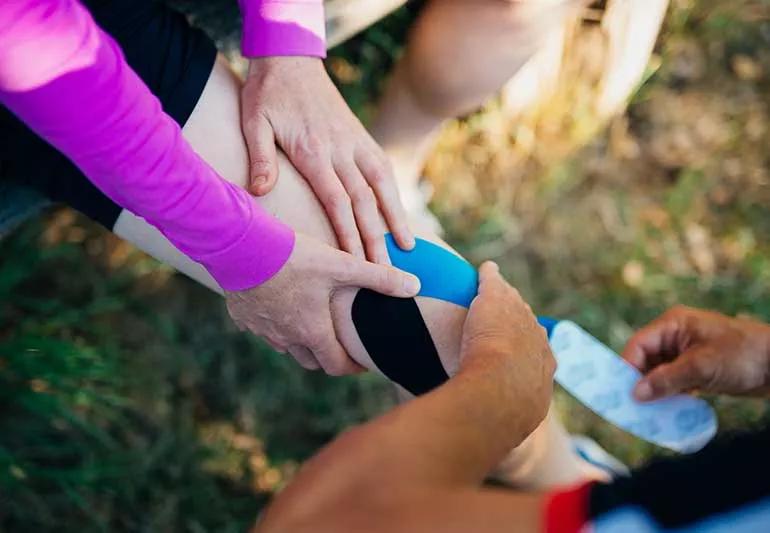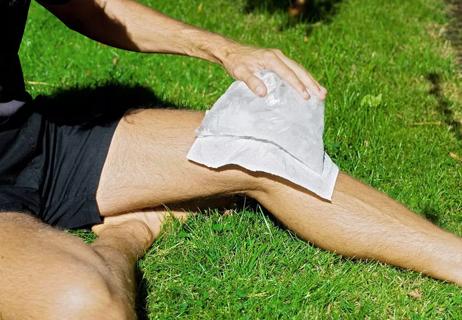Elastic therapeutic tape can provide extra support, but it can’t improve your stats

If you’ve ever watched the Olympics or basically any other sporting event, you’ve probably noticed athletes on the court or in the field, or even in the pool, wearing large pieces of brightly colored tape — not wrapped around their limbs but placed on top of their skin, often in long strips atop their muscles.
Advertisement
Cleveland Clinic is a non-profit academic medical center. Advertising on our site helps support our mission. We do not endorse non-Cleveland Clinic products or services. Policy
It’s not a fashion statement. It’s elastic therapeutic tape, a special type of stretchy, flexible athletic tape often used to help treat muscle and joint pain. But does it work?
Sports medicine physician Dominic King, DO, explains why you might use elastic therapeutic tape and what it can (and can’t) do for your body.
Often just called KT tape, elastic therapeutic tape is an elastic cotton strip with an acrylic adhesive on one side. It was invented in the 1970s by Dr. Kenzo Kase, whose Kinesio® Tex Tape is still popular today, though many other types have since cropped up.
Physical therapists and other healthcare providers use KT tape for a variety of reasons, including treating pain from sports injuries and improving athletic performance. You might also hear it called:
Not all athletic tape is created equal, and it’s not all meant to do the same thing.
There’s standard athletic tape (sometimes called strapping or rigid tape), which is thick and not stretchy. This traditional tape is used to immobilize a joint, like a wrist or ankle.
On the other hand, there’s KT tape, which is thin, stretchy and applied directly over a joint. Because it doesn’t limit movement the way traditional sports tape does, athletes can continue to wear it while they practice and compete.
Advertisement
“When you apply KT tape to a joint, it helps to act almost like a rubber band, supporting muscles and tendons and taking a little stress off the joints,” Dr. King explains. “It can also help relieve swelling in certain areas.”
Depending on your injuries or specific areas of pain, your physical therapist or other healthcare provider may recommend using KT tape on your:
To tape or not to tape? Dr. King walks us through some of the claims about KT tape and helps separate truth from fiction.
Went a little too hard? With the right guidance, KT tape can help you find some temporary relief by easing the intensity of your pain — but the keyword here is “temporary.”
“For the short term, it can help with some joints that might be painful, for a couple of hours or maybe for a day,” Dr. King says.
“Research suggests that Kinesio tape may help relieve pain for people with chronic musculoskeletal pain,” Dr. King notes, “though it’s not any more effective than other treatments.”
One study found that KT tape helped reduce pain in people with osteoarthritis, while research is mixed on whether KT tape can help relieve the pain of shoulder tendinitis. And there’s no conclusive scientific evidence that Kinesio tape can reduce disability in people with chronic pain.
Don’t expect KT tape to solve any ongoing pain or other issues. Research has yet to show any lasting benefit from using it.
“I wouldn’t rely on KT taping alone to treat your musculoskeletal conditions, but it may serve a role as one of many treatments that your provider recommends,” Dr. King says.
Because KT tape doesn’t restrict your movement, it’s good for giving extra support to your joints and muscles, especially if you deal with a chronic issue like:
Research suggests that KT tape provides some support to unstable ankles, and one study found that it helped protect martial artists’ Achilles tendons. Because of the bonus support it provides, some people also report feeling more comfortable being active with KT tape than without.
“Just be aware of the risk of being over-confident in how well the tape is going to work,” Dr. King cautions. “You don’t want to push your body too hard, and you don’t want to push through pain.”
Kinesio tape isn’t a standalone therapy, but it can be paired with other treatments.
“We don’t recommend using the tape as a first line of defense to treat muscle soreness, but rather as part of a program that includes rest, stretching, recovery and sometimes physical therapy to address underlying muscle imbalance or instability,” Dr. King states.
Advertisement
Some people may experience short-term performance benefits from using KT tape. But don’t expect to suddenly turn into a LeBron James-style athlete.
“Many people think using KT tape will give them an advantage over the athletic competition,” Dr. King says, “but it’s often more of a perceived effect than a real one.”
Research hasn’t ruled out the placebo effect when it comes to Kinesio tape — but you still shouldn’t count on it to give you a competitive advantage. Studies show that KT tape doesn’t affect track and field runners’ jump performance or soccer players’ overall performance, among other types of athleticism.
There aren’t yet many high-quality studies about using Kinesio tape after a musculoskeletal injury, but Dr. King says not to expect it to help you bounce back any faster.
Recovering from serious sports injuries calls for physical therapy by a trained sports therapy professional. “There’s really no replacement for the neuromuscular reeducation you get through physical therapy,” he says.
It may seem like no big deal to try to apply KT tape on your own, but not so fast. It’s much more than a simple bandage.
Kinesio tape should always be applied, at least initially, by a trained sports therapy professional who can determine how much tape you need, what direction it should be applied in and where it should go on your skin.
Advertisement
Without that proper guidance, Dr. King warns that you could actually make your pain worse. “Whenever you have muscle soreness — either pain during activity or lingering pain after activity — it’s important to see a healthcare professional to understand the underlying problem that’s causing that symptom.
“That leads to the right treatment for the right diagnoses, and ultimately, the right recovery.“
Advertisement
Learn more about our editorial process.
Advertisement

Care for your ears by steering clear of cotton swabs, taking precautions in loud settings and seeking medical help when needed

Fit, duration and positioning are more important than you might think

Building shoulder strength can minimize your risk of injury

Proper form is important when pivoting, turning and landing

Take the ache away from your joints with these at-home exercises

How to bounce back when a gymnastics injury has sidelined you

Help your gymnast stay healthy and strong with proper training and nutrition

Follow guidelines to limit pitches, rest between games

Type 2 diabetes isn’t inevitable with these dietary changes

Applying a hot or cold compress can help with pain